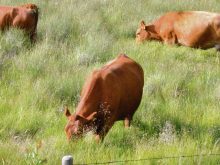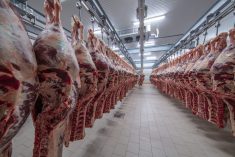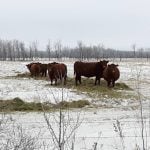Chicago Mercantile Exchange (CME) feeder cattle futures eased from a one-year high on Wednesday on overbought signals and despite another slide in corn prices that had been encouraging demand for young cattle, traders said.
Feeder cattle had soared to the highest price for a spot contract (158.4 cents per pound) since June 15 last summer and underwent a downward correction on Wednesday.
“Feeders just don’t work at these levels. I know corn prices and feed costs are lower but cattle feeders are losing money paying this price for feeders,” said Jim Clarkson, an analyst for A+A Trading Inc.
Read Also

U.S. grains: Soybean futures rise on active Chinese buying
Chicago | Reuters – U.S. soybean futures edged higher on Friday on increased Chinese demand for American supplies. Wheat and…
Chicago Board of Trade (CBOT) corn futures eased four cents per bushel at $4.94 by the close of trading on Wednesday, helping to limit the declines in feeder cattle futures (all figures US$).
Corn is the root foundation for U.S. feeding of cattle, hogs and poultry and the sliding corn price has helped buoy demand for young livestock and poultry to place on feed.
CME September feeder cattle futures closed down 0.15 cent/lb. at 157.025 cents, and October feeders ended up 0.15 at 159.25.
Cattle futures closed lower as the cash markets in the U.S. High Plains remained at a discount to the futures price.
“Cattle are technically weak and cash cattle are steady at best,” Clarkson said. “Also, futures are carrying a premium to cash.
Cattle slipped despite a firmer tone in the beef market. The U.S. Department of Agriculture’s (USDA) wholesale beef market report on Wednesday showed choice beef carcasses up 38 cents per hundredweight (cwt) at $196.48.
Estimated margins for U.S. beef packing companies on Wednesday were a positive $17 per head, up from $9.50 on Tuesday but down from $20.20 a week ago, according to Denver-based livestock marketing advisory service HedgersEdge.com LLC.
CME October live cattle futures closed down 0.2 cent/lb. at 126 cents, and December fell 0.2, to 129.9.
Lean hog futures closed higher on technical signals and despite generally weaker cash hog markets.
“The spread is narrowing between the index and cash and I think some people got too short and have had to cover. That and hogs are now technically strong,” Clarkson said.
The CME lean hog index price for the two days ending on Aug. 30 was at 92.4 cents/lb. and for the two days ending Aug. 29 was at 93.25.
Iowa and southern Minnesota cash hog markets were steady on Wednesday and dealers said there was an adequate supply to meet the current demand. Other cash hog buying stations also reported a steady market with the exception of a $1/cwt lower trend in Peoria.
USDA’s wholesale pork market report on Wednesday showed pork carcasses up $1.01/cwt, at $97.85.
Estimated margins for U.S. pork packing companies were a positive $8.15 per head on Wednesday, down from $9.10 on Tuesday and below the positive $12.35 a week ago.
CME October lean hogs were up 1.125 cents/lb. at 89.125 cents, and December closed up 0.875 at
85.85.
— Sam Nelson is a Reuters correspondent reporting on ag futures markets from Chicago.













